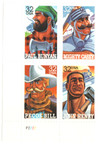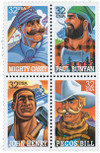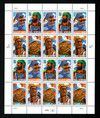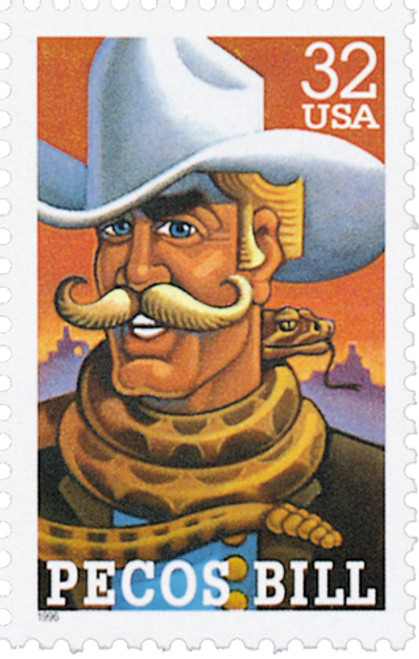
# 3083-86 - 1996 32c Folk Heroes
US #3083-86
1996 Folk Heroes
- Set of four features characters from American Folklore
Stamp Category: Commemorative
Set: Folk Heroes
Value: 32¢, First-class mail rate
First Day of Issue: July 11, 1996
First Day City: Anaheim, California
Quantity Issued: 23,687,500
Printed by: Ashton-Potter (USA) Ltd.
Printing Method: Lithographed
Format: Panes of 20 (5 across, 4 down) from plates of 120 subjects (8 across, 15 down)
Perforations: 11.1
Why the stamp was issued: The set of four Folk Heroes stamps were issued to celebrate folklore characters of America.
About the stamp design: The stamp artwork was made by Dave LaFleur, a commercial illustrator. His style is similar to murals and posters created during the New Deal era in America and Soviet propaganda art. LeFleur’s characters show strength through their thick necks and strong jaws. For his portraits, LaFleur didn’t want to be influenced by anyone else’s illustrations, so he read their stories in books without illustrations to develop his own images of the men. He painted the Folk Heroes using oil paints rather than acrylics or watercolors used for most stamp art.
Initially, the USPS had tasked Dave LaFleur with painting six folk heroes “ the four that were issued as well as Johnny Appleseed and Rip Van Winkle. They liked his paintings but decided to make it a set of four. Pecos Bill, Paul Bunyan, John Henry, and Mighty Casey were chosen to be portrayed.
First Day City: The Folk Heroes stamps were issued on the opening day of the American Stamp Dealers Association’s Postage Stamp Mega-Event, held in Anaheim, California. Actors portraying the four characters featured on the stamps were in attendance at the ceremony.
Unusual fact about these stamps: The Folk Heroes stamps weren’t the first to feature characters from American folklore. In 1966, the US Post Office Department began issuing stamps in the American Folklore series. These highlighted Johnny Appleseed, Davy Crockett, Daniel Boone, Grandma Moses, and Tom Sawyer, as well as Ichabod Crane and the Headless Horseman.
About the Folk Heroes stamps:
This set of four commemorates some of het greatest heroes of Aemrican folklore. These four men were known for their super human stregth and size, with a personality to match.
Mighty Casey: Baseball Hero
When the poem "Casey at the Bat" appeared in the San Francisco Examiner June 3, 1888, it was an instant hit and has remained so to this day. Baseball is America's favorite pastime and Ernest Lawrence Thayer captured the emotions that grip fans from time to time.
The poem opens with the hometown team, the Mudville nine, down four to two in the bottom of the ninth with two outs. The 5,000 fans are numb with melancholy. If only Casey were the next batter up, they could hope. But alas, two batters are ahead of Casey in the line-up.
Amazingly, Flynn snags a single. Blake, following, viciously slams the ball, stripping it of its very leather. Delirious hope sweeps melancholy away because Blake is safe on second, Flynn is a-huggin' third, and Casey is striding to the plate.
Casey lets the first pitch go "Strike one!" He lets the second go and it's "Strike two!" The crowd holds its collective breath. Casey clenches his teeth. He pounds his bat on the plate, and glares at the pitcher. The ball is hurled; Casey swings. He misses! The poem ends with the Mudville fans wrapped in total despair.
But "it ain't over 'til it's over." James Wilson gave Mudville its day of joy in the sequel "Casey's Revenge."
Paul Bunyan: Hero of the Lumberjacks
Logging was the principle work on the frontier after the great days of exploration and fur trapping. The cry for lumber at home and abroad kept loggers pushing deeper into the woods. It was during this push across the northern continent that Paul Bunyan became the lumberjack's hero.
Paul Bunyan stories evolved in logging shanties during the long winter evenings. After cutting and hauling from dawn to dusk, and after eating a filling meal, lumberjacks gathered 'round to exchange stories of the greatest lumberjack that ever was. As lumber camps followed the great forests westward, Paul Bunyan acquired the traits and exploits of other people.
The first written Paul Bunyan story, "The Round-River Drive," appeared in a Detroit newspaper in 1910.Â= Other simple, realistic stories followed. Then in 1914, W. B. Laughead began using Paul Bunyan to advertise the Red River Lumber Company of Westwood, California, and Paul Bunyan's exploits became superhuman. This was the time Paul acquired Babe, the Blue Ox. Together, fueled by a powerful mixture of flapjacks and syrup, they dug the Great Lakes and St. Lawrence River, shaved the slopes of the Rocky Mountains, and gouged the Grand Canyon - just for starters.
John Henry: Hero of Railroad Men
Of all America's tall tale heroes, John Henry was a real flesh-and-blood man. He worked as a gandy dancer - a steel-driving man, for the Chesapeake & Ohio Railroad. Sometime between 1870 and 1872, while drilling in the Big Bend Tunnel in West Virginia, John Henry died.
Shortly after that, both John Henry songs and stories sprang up. Songs set the rhythm for the grueling work on the line. The stories initiated new hands to the fraternity of steel-driving men - the men who moved mountains with sweat and blood so that the country could be bound together with iron rails. At the height of rail power, more than 100 hammer songs and over 100 ballads existed. One-upmanship, of course, made each tale more fantastic with the telling.
John Henry was special from birth. In some tales, he weighs 44 pounds; in others, he walks and talks at birth. In still others, he is born with a hammer in his hand. Full grown, John Henry could do anything that required muscle, and did it well. But more than anything else, John Henry's passion was to be a steel-drivin' man, the best there ever was.
That's why John Henry pitted his muscles against the machinery of a steam drilling machine and won. But his energy was spent, and he died with his hammer in his hand, gaining immortality.
Pecos Bill: America's First Cowboy
Pecos Bill was the first and best cowboy that ever was. He was the smartest, bravest, and most courageous of the men who tamed the wild American West.
As an infant, legendary Pecos Bill was lost near the Pecos River in Texas. Luckily, coyotes adopted him and raised him as their own. The first human Bill met was his brother, who named him Pecos Bill and took him to live at Hell's Gate Gulch Ranch.
Pecos Bill adjusted quickly to human ways and soon lassoed himself a feisty horse he named "Lightning" or "Widow Maker," depending on the story. The men asked Pecos Bill to run the ranch and teach them what he knew. Thus, cowboys learned to lasso and break a horse, how to cowpunch, rope cattle, ride herd, and hold a roundup. Though Pecos Bill had solutions for every problem, he always credited his coyote family for his abilities and knowledge.
As the years went by, cowboys around the fire embellished the feats and daring of Pecos Bill. So it is we have stories of him digging the Rio Grande, wrestling bears, taming mountain lions for fun, and riding cyclones bareback.
Edward O'Reilly published "The Saga of Pecos Bill" in 1923. Many stories of America's first cowboy followed.
US #3083-86
1996 Folk Heroes
- Set of four features characters from American Folklore
Stamp Category: Commemorative
Set: Folk Heroes
Value: 32¢, First-class mail rate
First Day of Issue: July 11, 1996
First Day City: Anaheim, California
Quantity Issued: 23,687,500
Printed by: Ashton-Potter (USA) Ltd.
Printing Method: Lithographed
Format: Panes of 20 (5 across, 4 down) from plates of 120 subjects (8 across, 15 down)
Perforations: 11.1
Why the stamp was issued: The set of four Folk Heroes stamps were issued to celebrate folklore characters of America.
About the stamp design: The stamp artwork was made by Dave LaFleur, a commercial illustrator. His style is similar to murals and posters created during the New Deal era in America and Soviet propaganda art. LeFleur’s characters show strength through their thick necks and strong jaws. For his portraits, LaFleur didn’t want to be influenced by anyone else’s illustrations, so he read their stories in books without illustrations to develop his own images of the men. He painted the Folk Heroes using oil paints rather than acrylics or watercolors used for most stamp art.
Initially, the USPS had tasked Dave LaFleur with painting six folk heroes “ the four that were issued as well as Johnny Appleseed and Rip Van Winkle. They liked his paintings but decided to make it a set of four. Pecos Bill, Paul Bunyan, John Henry, and Mighty Casey were chosen to be portrayed.
First Day City: The Folk Heroes stamps were issued on the opening day of the American Stamp Dealers Association’s Postage Stamp Mega-Event, held in Anaheim, California. Actors portraying the four characters featured on the stamps were in attendance at the ceremony.
Unusual fact about these stamps: The Folk Heroes stamps weren’t the first to feature characters from American folklore. In 1966, the US Post Office Department began issuing stamps in the American Folklore series. These highlighted Johnny Appleseed, Davy Crockett, Daniel Boone, Grandma Moses, and Tom Sawyer, as well as Ichabod Crane and the Headless Horseman.
About the Folk Heroes stamps:
This set of four commemorates some of het greatest heroes of Aemrican folklore. These four men were known for their super human stregth and size, with a personality to match.
Mighty Casey: Baseball Hero
When the poem "Casey at the Bat" appeared in the San Francisco Examiner June 3, 1888, it was an instant hit and has remained so to this day. Baseball is America's favorite pastime and Ernest Lawrence Thayer captured the emotions that grip fans from time to time.
The poem opens with the hometown team, the Mudville nine, down four to two in the bottom of the ninth with two outs. The 5,000 fans are numb with melancholy. If only Casey were the next batter up, they could hope. But alas, two batters are ahead of Casey in the line-up.
Amazingly, Flynn snags a single. Blake, following, viciously slams the ball, stripping it of its very leather. Delirious hope sweeps melancholy away because Blake is safe on second, Flynn is a-huggin' third, and Casey is striding to the plate.
Casey lets the first pitch go "Strike one!" He lets the second go and it's "Strike two!" The crowd holds its collective breath. Casey clenches his teeth. He pounds his bat on the plate, and glares at the pitcher. The ball is hurled; Casey swings. He misses! The poem ends with the Mudville fans wrapped in total despair.
But "it ain't over 'til it's over." James Wilson gave Mudville its day of joy in the sequel "Casey's Revenge."
Paul Bunyan: Hero of the Lumberjacks
Logging was the principle work on the frontier after the great days of exploration and fur trapping. The cry for lumber at home and abroad kept loggers pushing deeper into the woods. It was during this push across the northern continent that Paul Bunyan became the lumberjack's hero.
Paul Bunyan stories evolved in logging shanties during the long winter evenings. After cutting and hauling from dawn to dusk, and after eating a filling meal, lumberjacks gathered 'round to exchange stories of the greatest lumberjack that ever was. As lumber camps followed the great forests westward, Paul Bunyan acquired the traits and exploits of other people.
The first written Paul Bunyan story, "The Round-River Drive," appeared in a Detroit newspaper in 1910.Â= Other simple, realistic stories followed. Then in 1914, W. B. Laughead began using Paul Bunyan to advertise the Red River Lumber Company of Westwood, California, and Paul Bunyan's exploits became superhuman. This was the time Paul acquired Babe, the Blue Ox. Together, fueled by a powerful mixture of flapjacks and syrup, they dug the Great Lakes and St. Lawrence River, shaved the slopes of the Rocky Mountains, and gouged the Grand Canyon - just for starters.
John Henry: Hero of Railroad Men
Of all America's tall tale heroes, John Henry was a real flesh-and-blood man. He worked as a gandy dancer - a steel-driving man, for the Chesapeake & Ohio Railroad. Sometime between 1870 and 1872, while drilling in the Big Bend Tunnel in West Virginia, John Henry died.
Shortly after that, both John Henry songs and stories sprang up. Songs set the rhythm for the grueling work on the line. The stories initiated new hands to the fraternity of steel-driving men - the men who moved mountains with sweat and blood so that the country could be bound together with iron rails. At the height of rail power, more than 100 hammer songs and over 100 ballads existed. One-upmanship, of course, made each tale more fantastic with the telling.
John Henry was special from birth. In some tales, he weighs 44 pounds; in others, he walks and talks at birth. In still others, he is born with a hammer in his hand. Full grown, John Henry could do anything that required muscle, and did it well. But more than anything else, John Henry's passion was to be a steel-drivin' man, the best there ever was.
That's why John Henry pitted his muscles against the machinery of a steam drilling machine and won. But his energy was spent, and he died with his hammer in his hand, gaining immortality.
Pecos Bill: America's First Cowboy
Pecos Bill was the first and best cowboy that ever was. He was the smartest, bravest, and most courageous of the men who tamed the wild American West.
As an infant, legendary Pecos Bill was lost near the Pecos River in Texas. Luckily, coyotes adopted him and raised him as their own. The first human Bill met was his brother, who named him Pecos Bill and took him to live at Hell's Gate Gulch Ranch.
Pecos Bill adjusted quickly to human ways and soon lassoed himself a feisty horse he named "Lightning" or "Widow Maker," depending on the story. The men asked Pecos Bill to run the ranch and teach them what he knew. Thus, cowboys learned to lasso and break a horse, how to cowpunch, rope cattle, ride herd, and hold a roundup. Though Pecos Bill had solutions for every problem, he always credited his coyote family for his abilities and knowledge.
As the years went by, cowboys around the fire embellished the feats and daring of Pecos Bill. So it is we have stories of him digging the Rio Grande, wrestling bears, taming mountain lions for fun, and riding cyclones bareback.
Edward O'Reilly published "The Saga of Pecos Bill" in 1923. Many stories of America's first cowboy followed.

















